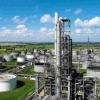|
|
Designing A Heat Exchanger
Started by , Sep 21 2008 04:24 AM
9 replies to this topic
Share this topic:
#1

Posted 21 September 2008 - 04:24 AM
My task is to design a heat exchanger for my final year project. Now, I'm faced with a problem in my design. My inlet stream to the tube side is vapor/liquid phase (hot fluid) and water (Cooling water supply) to the shell side. The hot fluid exiting the shell side is also in vapor/liquid phase. The conditions of my streams are listed below
Hot fluid entering the tube side:
Phase: vapor/liquid
T©: 110C
P(bar): 35.51bar
Molar Flow [kgmole/h]: 43637.5
Mass Flow [kg/s]: 233.17
vapor fraction: 0.6525
The composition, in mole fractions, is:
Ammonia = 8.57487042668511e-005
Hydrogen = 0.344944183608350
Methane = 2.52795211258508e-004
CO = 5.19772403699177e-003
CO2 = 0.245389560685118
H2O = 0.377429270027171
Nitrogen = 2.26202584264989e-002
Argon = 3.16753292976208e-003
HCN = 5.14831545223654e-009
COS = 1.54622844581293e-006
H2S = 9.11374993822935e-004
Total = 1.000000
Hot fluid exiting the tube side:
Phase: vapor/liquid
T©: 50 C
P(bar): 35.01 bar
Molar Flow [kgmole/h]: 43637.5
Mass Flow [kg/s]: 233.17
vapor fraction: 0.6250
coolant entering the shell side:
phase: liquid
Fluid: water
T©: 20 C
P(bar): 8 bar
coolant leaving the shell side:
phase: liquid
fluid: water
T©:
P(bar): 0.1257 bar
The above information was obtained from HYSYS. Now, I must design a heat exchanger using the above values. The question is: how am I gonna include condensation into my calculations?
Hot fluid entering the tube side:
Phase: vapor/liquid
T©: 110C
P(bar): 35.51bar
Molar Flow [kgmole/h]: 43637.5
Mass Flow [kg/s]: 233.17
vapor fraction: 0.6525
The composition, in mole fractions, is:
Ammonia = 8.57487042668511e-005
Hydrogen = 0.344944183608350
Methane = 2.52795211258508e-004
CO = 5.19772403699177e-003
CO2 = 0.245389560685118
H2O = 0.377429270027171
Nitrogen = 2.26202584264989e-002
Argon = 3.16753292976208e-003
HCN = 5.14831545223654e-009
COS = 1.54622844581293e-006
H2S = 9.11374993822935e-004
Total = 1.000000
Hot fluid exiting the tube side:
Phase: vapor/liquid
T©: 50 C
P(bar): 35.01 bar
Molar Flow [kgmole/h]: 43637.5
Mass Flow [kg/s]: 233.17
vapor fraction: 0.6250
coolant entering the shell side:
phase: liquid
Fluid: water
T©: 20 C
P(bar): 8 bar
coolant leaving the shell side:
phase: liquid
fluid: water
T©:
P(bar): 0.1257 bar
The above information was obtained from HYSYS. Now, I must design a heat exchanger using the above values. The question is: how am I gonna include condensation into my calculations?
#2

Posted 21 September 2008 - 05:55 AM
You have errors in your material balance: individual mole fractions should be numbers between 0 and 1, and the total sum of component mole fractions must be equal to 1. These are probably molar flows rather than fractions.
Secondly, placing cooling water on the shell-side is not good practice - unless you have some really good reasons to do it that way. However, we don't know any details about this particular system.
For designing heat exchangers involving partial phase change applications, contribution of both phases (and their individual film coefficients) in the overall heat exchange across the cooler have to be evaluated. Calculation details can be found in heat transfer textbooks - particularly Kern's "Process Heat Transfer", and textbook with the same title from Hewitt, Shires, and Bott. Some references are avilable at ChE website as well.
Depending on the amount of condensation and relative flows of liquid and vapor phases, certain simplifications can be made. For example, if the amount of heat duty used for condensation of vapors is less than 10-15% of total exchanger duty, neglecting condensation film coefficients contribution to the overall HTC will not result in design errors. The same applies if relative amount of liquid is small, as compared with vapor flow.
One good thing you can do is to fill the exchanger datasheet accurately, and send it to equipment manufacturers. That way, you'll be able to compare two designs and see what has been missing in your calculation approach.
Secondly, placing cooling water on the shell-side is not good practice - unless you have some really good reasons to do it that way. However, we don't know any details about this particular system.
For designing heat exchangers involving partial phase change applications, contribution of both phases (and their individual film coefficients) in the overall heat exchange across the cooler have to be evaluated. Calculation details can be found in heat transfer textbooks - particularly Kern's "Process Heat Transfer", and textbook with the same title from Hewitt, Shires, and Bott. Some references are avilable at ChE website as well.
Depending on the amount of condensation and relative flows of liquid and vapor phases, certain simplifications can be made. For example, if the amount of heat duty used for condensation of vapors is less than 10-15% of total exchanger duty, neglecting condensation film coefficients contribution to the overall HTC will not result in design errors. The same applies if relative amount of liquid is small, as compared with vapor flow.
One good thing you can do is to fill the exchanger datasheet accurately, and send it to equipment manufacturers. That way, you'll be able to compare two designs and see what has been missing in your calculation approach.
#3

Posted 21 September 2008 - 01:27 PM
Dear vchemeng Hello/Good Night,
I must tell you have got a 'nice systematic approach' suggested by Mr.Zauberberg. Please do follow, as this should yield positive outcome.
Cooling Water stream if kept on shell and localized 100 C plus temperatures may progressively scale the tubes externally thus affecting efficiency and reduced operating cycle; that’s why He has cautioned you.
Best regards
Qalander
I must tell you have got a 'nice systematic approach' suggested by Mr.Zauberberg. Please do follow, as this should yield positive outcome.
Cooling Water stream if kept on shell and localized 100 C plus temperatures may progressively scale the tubes externally thus affecting efficiency and reduced operating cycle; that’s why He has cautioned you.
Best regards
Qalander
#4

Posted 23 September 2008 - 10:38 PM
are you sure your cooling water pressure at outlet is 0.12bar?....that means you are going to have approx 8 bar pressure drop. That appears heaps to me.......also with this pressure, you wont be able to send back the return water back to cooling water basin.....I reckon you need to revisit your numbers again and make them sensible....
#5

Posted 24 September 2008 - 12:30 PM
QUOTE (flash @ Sep 23 2008, 07:38 PM) <{POST_SNAPBACK}>
are you sure your cooling water pressure at outlet is 0.12bar?
flash is absolutely correct in questioning the CW outlet pressure; it should be much more than what you are indicating. There are several other impracticalities and errors that were brought to your attention. As Zauberberg indicates, and I would have said it more emphatically than he, cooling water belongs on the tube side of this exchanger. And you appear to be dealing with molar flowrates, not fractions. Other aspects of your query make little sense. You bombard us with "data", but much of it is useless. Meanwhile, you fail to include useful information like thermo and transport properties. My suggestion is that you get hold of a heat exchanger process datasheet and then you'll see what is/is not important. Hysys should be able to provide the bulk of the needed data; the exchanger vendor would provide the rest. One last point - the exchanger you describe could hardly be called a "condenser". Here you are dropping 65 degrees C, yet there is an insignificant increase in the mass flowrate of the liquid phase. What change there is seems likely due to a small amount of absorption of (essentially) noncondensibles.
#6

Posted 15 May 2009 - 01:37 AM
Does every HE always flow the cooling fluid inside the tube? Or is it just for cooling water only?
Thank you
Thank you
#7

Posted 15 May 2009 - 08:22 AM
Everyone:
I've taken the liberty of editing the O.P.'s original post and checked the composition in order to have a more readable and legible script. I found the composition's sum to be logical as 1.000000 mol fraction by pasting it in Excel and letting the spreadsheet add it up for me.
I'm on my way out the door to see a doc about a physical exam, so I can't write more. I hope this helps everyone for now.
#8

Posted 15 May 2009 - 11:00 AM
May Lord of Universe Keep you well and Healthy Art!
#9

Posted 15 May 2009 - 01:10 PM
QUOTE (Skyline @ May 14 2009, 10:37 PM) <{POST_SNAPBACK}>
Does every HE always flow the cooling fluid inside the tube? Or is it just for cooling water only?
This is one of the infamous "rules of thumb" - put cooling water on the tube side of a shell & tube heat exchanger. Like all other rules of thumb, feel free to violate it as long as you know what you're doing. It is a suggestion based on the fact that cooling water is prone to fouling which can be minimized by maintaining a reasonably high velocity and avoiding stagnant areas where the temperature may be higher than the average. Both of these desirable outcomes are more easily achieved on the tube side of a S&T exchanger, hence the suggestion. This rule of thumb, however, will often conflict with other rules fo thumb such as keep the higher pressure fluid on the tube side, put the dirtier fluid on the tube side, put the more corrosive fluid on the tube side, etc. What to do? As everything in engineering, it's a tradeoff. Examine the pros and cons of the choices, quantitatively if possible, and select the best of your options (often best = least bad). This particular rule applies just to cooling water, and not to other (clean) cooling fluids.
#10

Posted 20 May 2009 - 12:10 AM
Ok, i understand your explanation. Thank you very much.
Similar Topics
Steam Pressure In Heat ExchangerStarted by Guest_mvanrijnbach_* , 15 Apr 2025 |
|

|
||
Heat Exchanger Steam FlowStarted by Guest_aliebrahem17_* , 25 Nov 2024 |
|

|
||
Discussion - Predict Storage Tank Heat Transfer Precisely By Jimmy D KStarted by Guest_raj shekhar_* , 25 Mar 2025 |
|

|
||
Cross Over Temperature In Countercurrent Heat ExchangerStarted by Guest_panoska_* , 18 Feb 2025 |
|

|
||
Aspen Hysys - Blowdown Utility Heat Flux MethodStarted by Guest_yuvi.ardekar1999@gmail.com_* , 27 Feb 2025 |
|

|

 FB
FB










